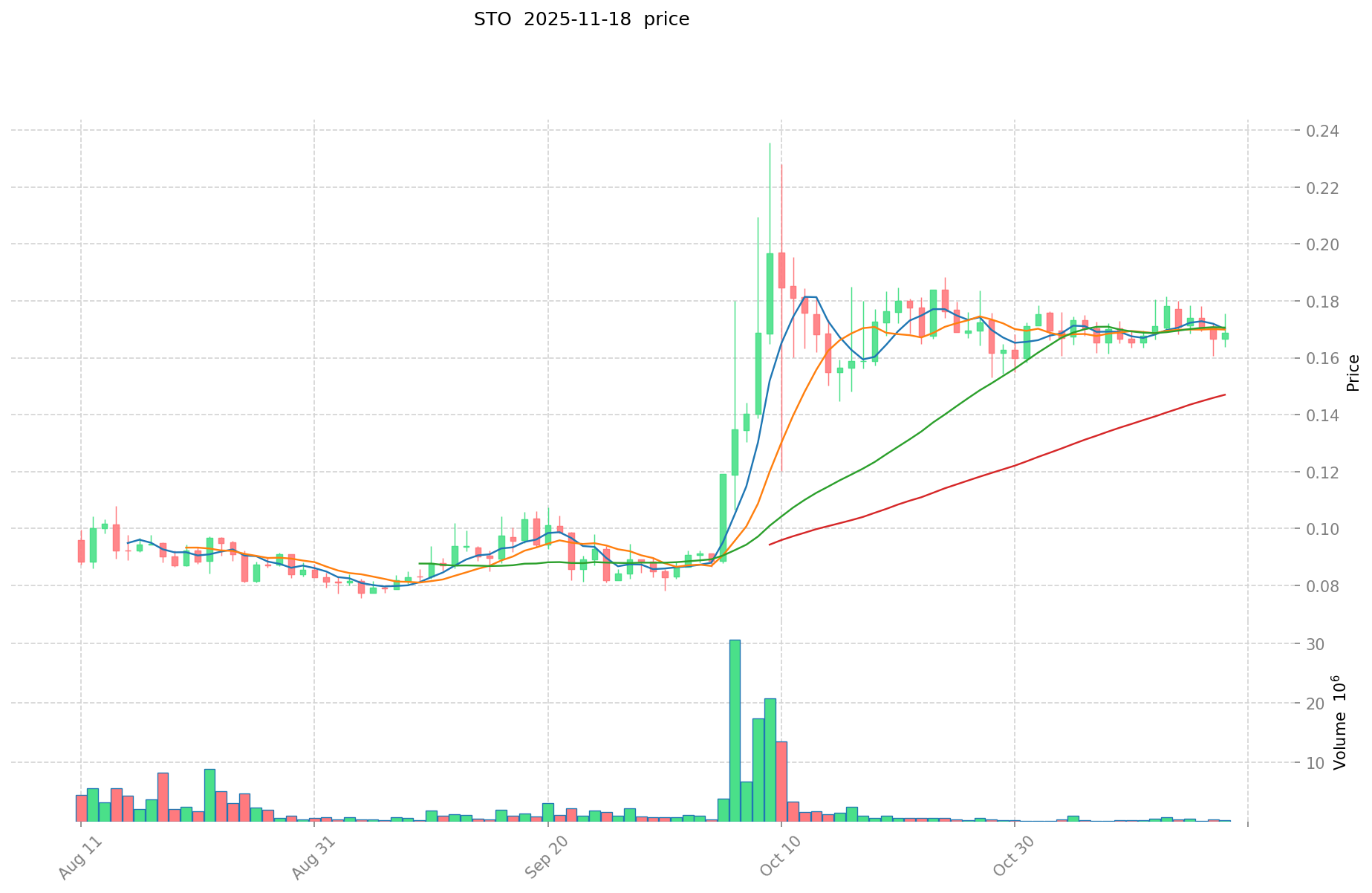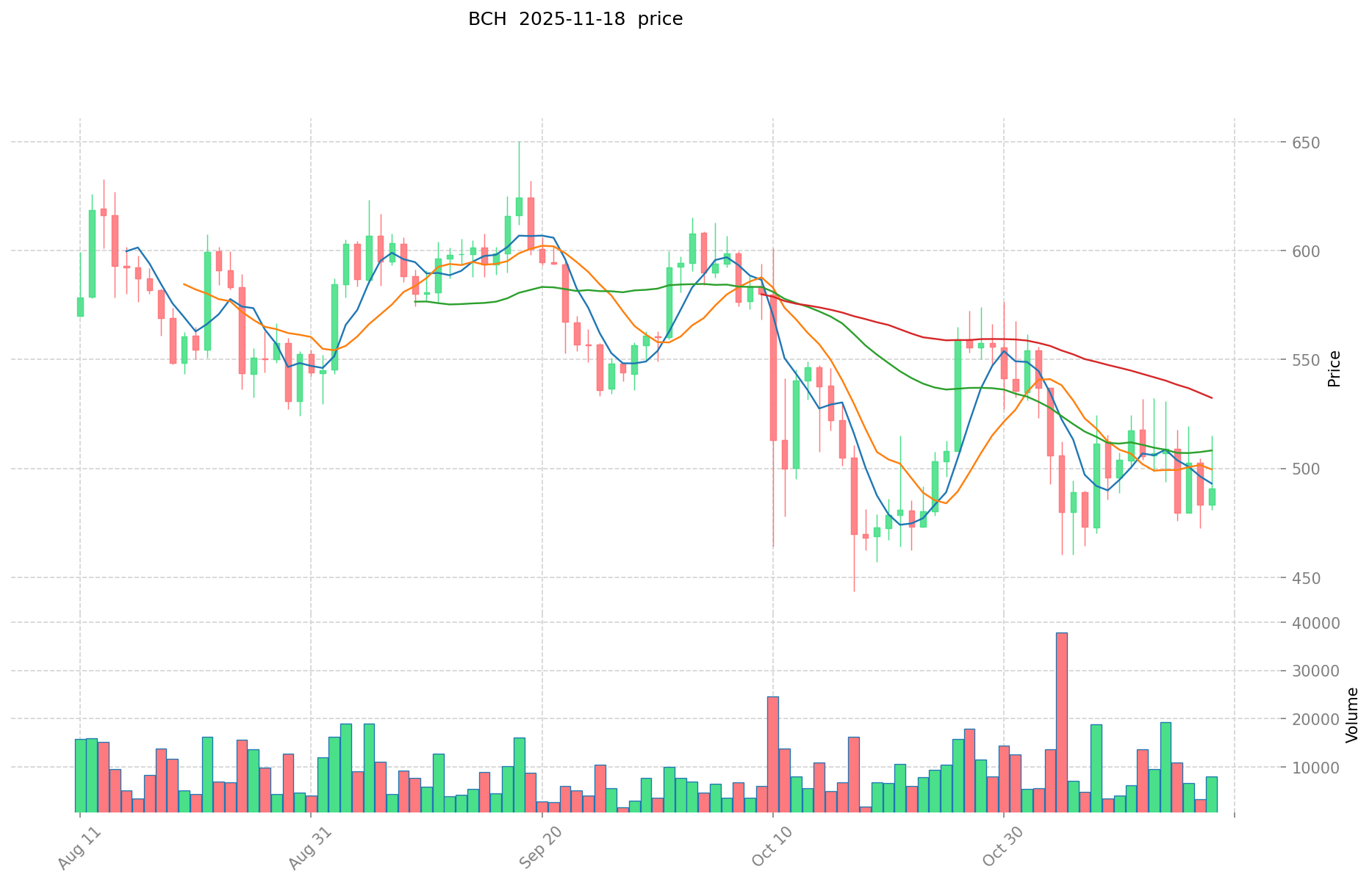STO vs BCH: A Comparative Analysis of Security Token Offerings and Bitcoin Cash
Introduction: STO vs BCH Investment Comparison
In the cryptocurrency market, StakeStone (STO) vs Bitcoin Cash (BCH) comparison has always been a topic that investors can't avoid. The two not only have significant differences in market cap ranking, application scenarios, and price performance, but also represent different cryptocurrency positions.
StakeStone (STO): Since its launch, it has gained market recognition for its decentralized omnichain liquidity infrastructure protocol.
Bitcoin Cash (BCH): Launched in 2017, it has been hailed as a peer-to-peer electronic cash system, and is one of the cryptocurrencies with the highest global trading volume and market capitalization.
This article will comprehensively analyze the investment value comparison between STO and BCH in terms of historical price trends, supply mechanisms, institutional adoption, technological ecosystems, and future predictions, and attempt to answer the question that investors care about most:
"Which is the better buy right now?" I. Price History Comparison and Current Market Status
StakeStone (STO) and Bitcoin Cash (BCH) Historical Price Trends
- 2025: STO reached an all-time high of $0.2365 on May 2nd.
- 2017: BCH was created through a hard fork of Bitcoin, reaching an all-time high of $3,785.82 on December 20th.
- Comparative analysis: In recent market cycles, STO dropped from its high of $0.2365 to a low of $0.0526, while BCH has fallen from its peak of $3,785.82 to current levels around $486.
Current Market Situation (2025-11-18)
- STO current price: $0.16869
- BCH current price: $486.34
- 24-hour trading volume: STO $61,892 vs BCH $4,954,646
- Market Sentiment Index (Fear & Greed Index): 11 (Extreme Fear)
Click to view real-time prices:
- View STO current price Market Price
- View BCH current price Market Price


II. Key Factors Affecting STO vs BCH Investment Value
Supply Mechanism Comparison (Tokenomics)
- STO: Requires projects to have fixed assets, higher compliance costs, and narrower fundraising audience compared to ICOs
- BCH: Affected by hash power wars, impacting its fundamental value
- 📌 Historical pattern: Market lacks new hotspots and capital inflow, which influences price cycle changes
Institutional Adoption and Market Applications
- Institutional Holdings: STOs have qualified investor requirements, limiting wider adoption
- Enterprise Adoption: STO serves as a legalized ICO and a more flexible IPO option for fundraising
- Regulatory Attitudes: Central bank officials have criticized STOs, creating regulatory challenges
Technical Development and Ecosystem Building
- STO Technical Features: Designed as a security token with underlying asset requirements
- BCH Technical Development: Faces challenges from hash power wars affecting network stability
- Ecosystem Comparison: Limited project value delivery from ICO projects has affected overall market perception
Macroeconomic Factors and Market Cycles
- Performance in Inflationary Environments: On-chain metrics like new addresses and active addresses impact internal value assessment
- Monetary Policy Impact: Exchange inflows and user activity metrics reflect market sentiment
- Cross-border Transaction Demand: Market trends and lack of new capital inflow are key factors affecting both asset classes
III. 2025-2030 Price Prediction: STO vs BCH
Short-term Prediction (2025)
- STO: Conservative $0.1498048 - $0.16832 | Optimistic $0.16832 - $0.2137664
- BCH: Conservative $270.9392 - $483.82 | Optimistic $483.82 - $556.393
Mid-term Prediction (2027)
- STO may enter a growth phase, with estimated price range $0.1598076368 - $0.3196152736
- BCH may enter a consolidation phase, with estimated price range $357.9372933 - $848.65777605
- Key drivers: Institutional fund inflows, ETF, ecosystem development
Long-term Prediction (2030)
- STO: Base scenario $0.38245620232224 - $0.4780702529028 | Optimistic scenario $0.4780702529028+
- BCH: Base scenario $738.0965807754084 - $878.68640568501 | Optimistic scenario $878.68640568501 - $957.7681821966609
Disclaimer: The above predictions are based on historical data and market analysis. Cryptocurrency markets are highly volatile and subject to change. This information should not be considered as financial advice. Always conduct your own research before making investment decisions.
STO:
| 年份 | 预测最高价 | 预测平均价格 | 预测最低价 | 涨跌幅 |
|---|---|---|---|---|
| 2025 | 0.2137664 | 0.16832 | 0.1498048 | 0 |
| 2026 | 0.265550048 | 0.1910432 | 0.179580608 | 13 |
| 2027 | 0.3196152736 | 0.228296624 | 0.1598076368 | 35 |
| 2028 | 0.399975685248 | 0.2739559488 | 0.16437356928 | 62 |
| 2029 | 0.42794658762048 | 0.336965817024 | 0.22913675557632 | 99 |
| 2030 | 0.4780702529028 | 0.38245620232224 | 0.240947407463011 | 126 |
BCH:
| 年份 | 预测最高价 | 预测平均价格 | 预测最低价 | 涨跌幅 |
|---|---|---|---|---|
| 2025 | 556.393 | 483.82 | 270.9392 | 0 |
| 2026 | 634.52993 | 520.1065 | 374.47668 | 6 |
| 2027 | 848.65777605 | 577.318215 | 357.9372933 | 18 |
| 2028 | 770.027035167 | 712.987995525 | 663.07883583825 | 46 |
| 2029 | 1015.86529602402 | 741.507515346 | 652.52661350448 | 52 |
| 2030 | 957.7681821966609 | 878.68640568501 | 738.0965807754084 | 80 |
IV. Investment Strategy Comparison: STO vs BCH
Long-term vs Short-term Investment Strategies
- STO: Suitable for investors focused on security token potential and regulatory compliance
- BCH: Suitable for investors seeking established networks and peer-to-peer electronic cash systems
Risk Management and Asset Allocation
- Conservative investors: STO: 20% vs BCH: 80%
- Aggressive investors: STO: 40% vs BCH: 60%
- Hedging tools: Stablecoin allocation, options, cross-currency portfolios
V. Potential Risk Comparison
Market Risk
- STO: Limited liquidity and market depth
- BCH: Volatility and competition from other cryptocurrencies
Technical Risk
- STO: Scalability, network stability
- BCH: Hash power concentration, security vulnerabilities
Regulatory Risk
- Global regulatory policies have different impacts on both assets
VI. Conclusion: Which Is the Better Buy?
📌 Investment Value Summary:
- STO advantages: Regulatory compliance, potential for tokenized securities
- BCH advantages: Established network, higher liquidity, peer-to-peer electronic cash system
✅ Investment Advice:
- New investors: Consider a balanced approach with a bias towards BCH due to its established history
- Experienced investors: Explore opportunities in both assets, with a higher allocation to BCH
- Institutional investors: Consider STO for potential in security token offerings, while maintaining significant exposure to BCH
⚠️ Risk Warning: The cryptocurrency market is highly volatile. This article does not constitute investment advice. None
VII. FAQ
Q1: What are the key differences between STO and BCH? A: STO is a security token with underlying asset requirements, while BCH is a peer-to-peer electronic cash system. STO focuses on regulatory compliance and tokenized securities, whereas BCH aims to be a widely used cryptocurrency for transactions.
Q2: Which has performed better historically, STO or BCH? A: BCH has historically reached higher price levels, with an all-time high of $3,785.82 in 2017. STO's all-time high was $0.2365 in 2025. However, both have experienced significant price fluctuations over time.
Q3: How do the supply mechanisms of STO and BCH differ? A: STO requires projects to have fixed assets and higher compliance costs, limiting its fundraising audience. BCH's supply is affected by hash power wars, which can impact its fundamental value.
Q4: What are the main risks associated with investing in STO and BCH? A: For STO, main risks include limited liquidity, market depth, and regulatory challenges. For BCH, risks include high volatility, competition from other cryptocurrencies, and potential security vulnerabilities due to hash power concentration.
Q5: How do institutional adoptions compare between STO and BCH? A: STOs have qualified investor requirements, limiting wider adoption. BCH, being more established, has higher trading volumes and market capitalization, potentially indicating broader institutional interest.
Q6: What are the long-term price predictions for STO and BCH by 2030? A: By 2030, STO's base scenario price range is predicted to be $0.38245620232224 - $0.4780702529028, while BCH's base scenario range is $738.0965807754084 - $878.68640568501. However, these predictions are subject to market volatility and should not be considered financial advice.
Q7: How should investors allocate their portfolio between STO and BCH? A: Conservative investors might consider allocating 20% to STO and 80% to BCH, while aggressive investors might opt for 40% STO and 60% BCH. However, individual allocations should be based on personal risk tolerance and investment goals.
Share
Content